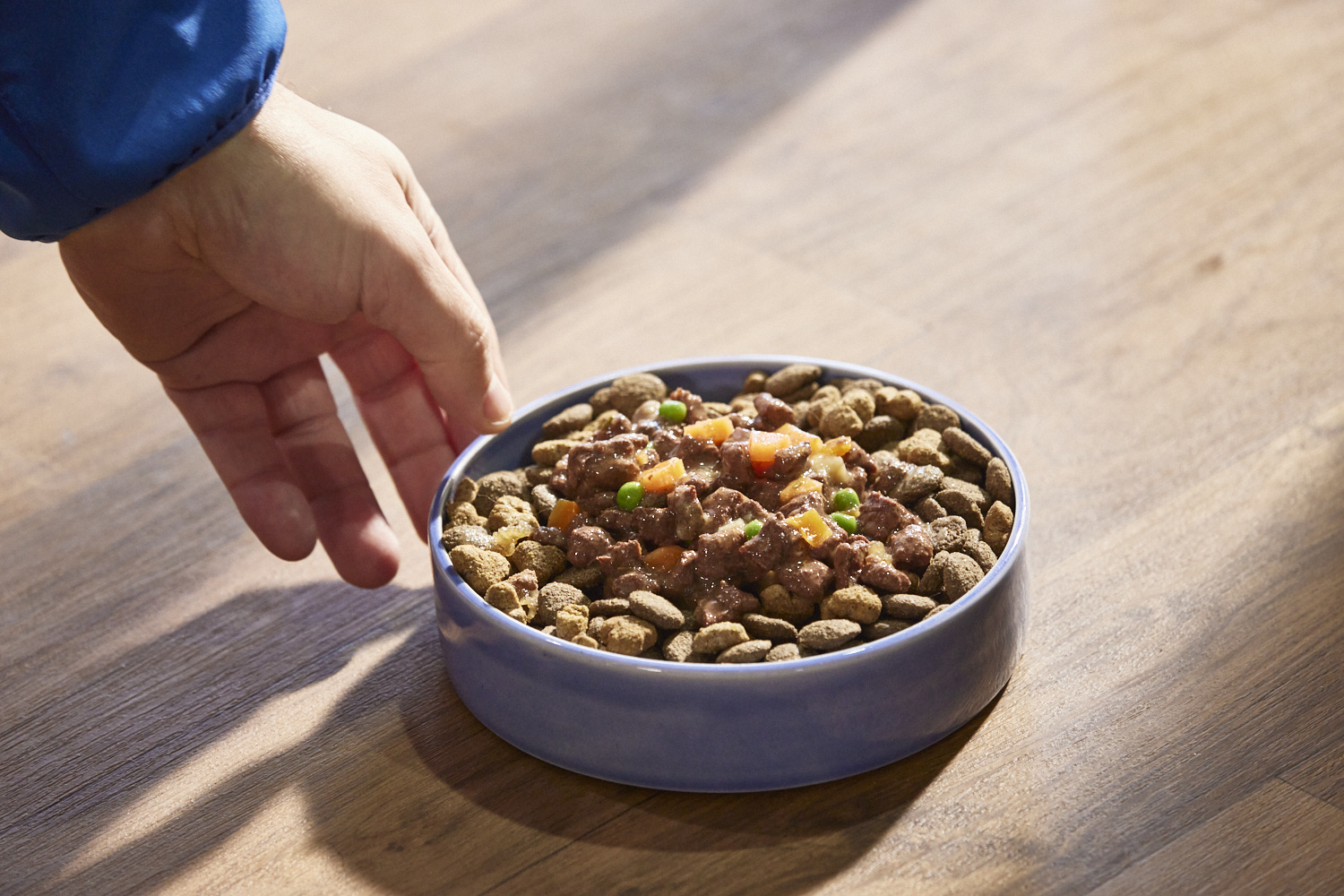Just like us, our canine companions have varying nutritional needs throughout their lives. From playful puppies to distinguished seniors, understanding these evolving dietary requirements is key to a long, healthy and happy life together. But navigating dog food life stages can feel tricky. Whether it’s working out what stage your pup is in, or dodging the “one-size-fits-all” approach, how do you keep up?
That’s where we come in.

Adaptive Nutrition: dog food life stages covered
With Tails.com, your dog’s kibble blend is 100% tailored to their needs. That means it adapts for every life stage too.
Our unique Adaptive Nutrition system gently tweaks over 40 key nutrients as your pup moves through life’s key milestones. Designed with our Vet and Nutrition team, it’s our way to ensure they get the support they need, every step of the way.
The really clever bit? All changes are done gradually over several deliveries. This means your dog likely won’t notice any change, and their digestion will be supported through the transition.
And of course – it’s always 100% tailored. Your dog’s needs, dislikes, and preferences still stand.
Whether they’re growing into those paws or enjoying a slower pace of life, know they’ll be getting everything they need. It’s all part of your plan.
How does Adaptive Nutrition work?
For you as an owner, it means:
- The nutrients in your dog’s blend will slowly change over time, giving them everything they need as they get older.
- There’s no need to change food, ever again.
- You’re always in control – tell us if your dog’s needs change, and we’ll do the rest.
For your dog, this means:
- Enjoying all the goodness they need, all from their kibble.
- No upset stomachs from abrupt changes in diet.
- Always getting the right nutrition at every life stage transition.

Dog food life stages explained
To show you what it looks like in reality, we thought we’d start with how we look after your puppy.
Successful starts: feeding the puppy stage
It’s amazing how fast puppies change. Not just in height, but in personality too. They’re teething, learning, and exploring the world. That means dog food for puppies needs to adapt to fuel their every move, helping them grow into the good boys and girls of tomorrow.
If they work for your puppy, we can add:
- Salmon oil to help support brain and vision development.
- A variety of grains and other carbohydrates for slow-release energy.
- High-quality proteins to fuel all that growing.
- Balanced calcium and phosphorus for healthy bone growth.
The next steps: adult dog food
When a puppy reaches adult dog food age, we focus on maintaining their health and well-being, so they might get some of these additions:
- Prebiotics like chicory extract to promote healthy gut flora.
- Natural yucca to help make those poos less smelly (you’ll be happy to know!).
- Portion adjustments to help them stay in great shape.
- Tailored support for their unique needs.
- Proteins in their favourite flavours to ensure those bowls are licked clean.
Optimal nutrition for senior dogs
To make those golden years truly golden, our senior dog food can offer them enhanced support:
- Chondroitin and glucosamine to help support joint health and mobility.
- Reduced calories and modified portions to help them stay in great shape.
Q&A with an Animal Nutritionist
Meet resident Nutritionist Fiona Firth. With over 20 years of expertise in the world of pets, she’s here to answer your frequently asked questions about life stage dog food.

When can puppies eat dry food?
From around three weeks of age, puppies can begin to eat specially formulated puppy food (either wet or dry food softened with water) as part of the weaning process. During this period, they will continue to nurse and take milk from their mother while gradually increasing their intake of solid food. Over time, the amount of water added to the food can be reduced as the puppies become more accustomed to eating independently.
By the time your puppy is ready to come home at eight weeks old, they should be fully weaned and able to eat dry puppy food. However, you may continue to add a little warm water if they show a preference for it.
When can my puppy eat adult food?
This depends on the breed and weight of your puppy. Smaller breeds can sometimes finish growing as early as 8 months old, many months before larger breeds. Giant breeds can still be growing past 18 months old. Our Adaptive Nutrition system will gradually change your puppy’s food blend when your individual dog reaches adulthood, based on their weight, current body condition and their breed size. We make these changes gradually, without you having to do anything, to help minimise any potential digestive upset from a change in diet. So, we’ve got you covered!
What happens if I change my dog’s food too quickly?
Changing dog food too quickly can cause your dog to exhibit digestive symptoms like loose stools, flatulence, bringing up bile, hunger, more frequent stools, or weight loss. So, it’s always best to take it slow. Any changes in dog food should be done gradually over 7 days to minimise any potential digestive upset.
Luckily, once your pup is on Tails.com food, our clever system uses the information you give us about your dog’s breed, age and weight to gradually change diets between life stages or when you update their profile. So you don’t have to worry about transitions ever again.
What about “all life stages” dog food?
Puppies need more calories, protein, fat, and higher levels of some vitamins and minerals for growth than adult dogs. In some cases, puppies will need lower levels of minerals than senior dogs, such as calcium. Feeding a puppy on a senior or adult diet could result in nutrient deficiencies or excesses that might affect their development. Because puppy food has different requirements, and higher fat and calorie requirements, it’s not advised to feed it to an adult dog or ageing dog either. This could result in weight issues, excessive nutrients, or deficiencies. You can always speak to your vet if you’re looking for more information on life-stage appropriate dog food.
If you have any questions dog food life stages, or about the way that Adaptive Nutrition works, please get in touch at hello@tails.com or pop a question in the comments below.


Hi, we have a 12month old Cockalier, called Sadie and she has just been spayed. Does her diet need to change?
She is currently on Acanna + Purina for digestion sensitivity + fresh chicken or fish topper. She also has a drizzle of fish oil in the morning. She weighs 11kg and is extremely active
Hi – please email us at hello@tails.com 🙂
The tail.com is not good for my two pets Diamond and Snow because they both keep eating each other food.
Sounds like they’re loving the food, D! If you think they’d both enjoy trying a new flavour – please pop our team an email at hello@tails.com and they can take a look at switching them to something they may prefer (each others flavour by the sounds of it!)
Hi
My 9 year old cavapoo has IBD and we have always loved your food because its one of the only ones he tolorates. Ive worked with your vet to find out what he’s allergic to and found the perfect blend. However last October he developed a cough and I’ve been taking him to the vet to find out what the problem is. She said is could be diet and I therefore have whatsapped you to ask whether his food has been changed around that time. You have confirmed it was.
I’m now struggling to get an explanation as to why it was changed and what precisely was changed without asking me. I’ve just been sent a link to this page.
Please can you urgently contact me to help.
Hi Charlotte, We’re really sorry to hear this, and our Customer & Nutrition team would love to take a closer look and help where they can. Just drop us an email with your details at hello@tails.com. We hope your pup is feeling better soon 💙